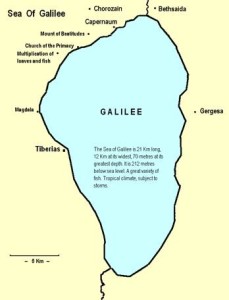This is the fifth installment in our series on undesigned coincidences in the gospels, based on a presentation by Dr. Tim McGrew. For an introduction to undesigned coincidences and this series, go here.
More Feeding of the 5,000
In this article, we’ll consider several undesigned coincidences that are spread across three gospels that provide an even more complete picture of the feeding of the 5,000.
Let’s get started with Matthew 11:21 (NIV), in which Jesus is castigating some unrepentant towns:
21 “Woe to you, Chorazin! Woe to you, Bethsaida! For if the miracles that were performed in you had been performed in Tyre and Sidon, they would have repented long ago in sackcloth and ashes.
Now here’s our first question: What “miracles” is Jesus referring to that were performed in Bethsaida? Matthew does not tell us. However, by piecing together data found in Luke and John, a clearer picture emerges.
This may take a minute, but hang with it, because it’s very interesting how everything ties together.
Let’s now consider John 6:5 (NIV), which is part of John’s set-up to the feeding of the 5,000:
5 When Jesus looked up and saw a great crowd coming toward him, he said to Philip, “Where shall we buy bread for these people to eat?”
OK, this raises a second question: Why did Jesus ask Philip if he knew where they could buy food? Philip is a very minor character in the gospels. Why would Jesus think Philip had any idea about where food could be found in the town?
On to the next passage…I promise this will all fit together.
Let’s look at Luke 9:10-11 (NIV), which is part of Luke’s set-up for the feeding of the 5,000 story:
10 When the apostles returned, they reported to Jesus what they had done. Then he took them with him and they withdrew by themselves to a town called Bethsaida, 11 but the crowds learned about it and followed him. He welcomed them and spoke to them about the kingdom of God, and healed those who needed healing.
Remember question 1, from Matthew 11:21 above: To what miracle in Bethsaida was Jesus referring? Luke inadvertently tells us. Jesus must have been referring to the feeding of the 5,000, because Luke informs us that this event took place in Bethsaida. Luke answers a question that was raised in Matthew’s account.
But, we’re not finished. What about the second question…the one about Philip? Let’s look at John 12:21, which is a passage totally unrelated to the feeding of the 5,000. In an off-hand way, it tell us:
21 They came to Philip, who was from Bethsaida in Galilee,…
So, Phillip was from Bethsaida. That explains why Jesus asked Phillip (in John 6:5) if he knew where to buy food. He was basically saying, “Hey, Phillip…You’re from around here. Do you know where we can get some food?”
Conclusion
Luke’s account and John’s account interlock in a fascinating way that lends detail to the story, and strengthens the historical credibility of each. In a completely independent and unintentional way, their stories support one another perfectly. In addition, Matthew’s account also plugs in perfectly, further supporting the narrative.
The feeding of the 5,000 was the miracle Jesus referred to when he said, “For if the miracles that were performed in you had been performed in Tyre and Sidon, they would have repented long ago in sackcloth and ashes.”
It’s important to note that Matthew often arranges his material thematically, rather than telling the stories in strict chronological order. When we look at Luke’s account of the feeding miracle, we can determine that it took place in Bethsaida prior to Jesus’ castigation of the town.
The interlocking nature of these separate accounts is exactly what we’d expect to see when studying accurate, independent, historical accounts of the same events. They corroborate one another in fascinating ways.

